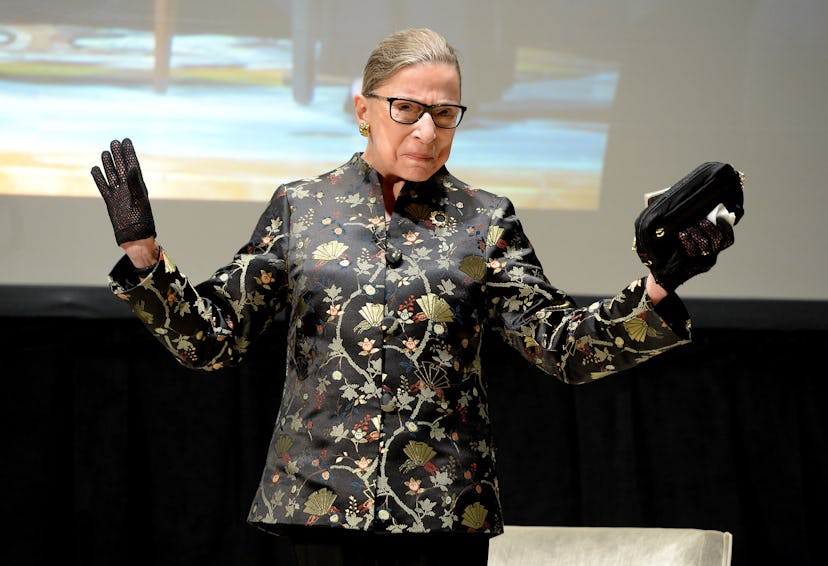Supreme Court Justices Sound Like Fashion Critics in New Case About Designer Knockoffs
“The clothes on the hanger do nothing,” said Justice Stephen Breyer. “The clothes on the woman do everything.”

“The clothes on the hanger do nothing,” Justice Stephen Breyer said during deliberations earlier this week. “The clothes on the woman do everything. And that is, I think, what fashion is about.”
For a group of people who show up to work day in and day out in the same shapeless black robes, the justices of the Supreme Court certainly had a lot to say about fashion this week.
Indeed the SCOTUS was considering a case that, depending on the wording of their ruling, could shake up the fashion industry, and more precisely the thriving design knock-off segment of it.
The case itself has little to do with high fashion. Varsity Brands, a Tennessee-based company, has become a giant in the niche world of cheerleading. Like ladies who lunch who wouldn’t be caught dead stepping out in a suit other than Chanel, bombshells who couldn’t imagine an outfit being truly complete without Louboutin’s red bottomed heels, or power brokers who think anyone who wears a watch other than a Rolex must be kidding themselves, discerning cheerleaders prefer to get their uniforms from Varsity. Its Spirit division is by far the leader in supplying cheerleading gear.
Well, rival company Star Athletica, LLC began selling uniforms that look awfully similar to Varsity’s and included elements that may have infringed on designs that Varsity copyrighted.
Though lower courts have been all over the place when it comes to how copyright protections should be applied to clothing, the Supremes decided this might be the perfect case to clear things up.
The Justices are well aware that the implications could reach far beyond cheerleading uniform design, and may have an impact on clothing knock-offs as well.
“You’re killing knockoffs with copyright,” Justice Sonia Sotomayor said during deliberations, according to the New York Times. “You haven’t been able to do it with trademark law. You haven’t been able to do it with patent designs. We are now going to use copyright law to kill the knockoff industry.”
“For a hundred and more than that years, the fashion industry has not enjoyed copyright protection,” added Breyer at another point. “On the women’s side, I believe, $225 billion, at least, worth of clothes are sold every year. If suddenly in this case we say that dresses are copyrightable, and they are because every one of them has some design, perhaps we’ll double the price of women’s clothes.”
The status of what types of knock-offs are considered legal or not is a bit confusing. Particular designs, images, logos and even fabric prints can be protected under a copyright or trademark. That’s why you can’t slap Louis Vuitton’s monogram on anything else but official Louis Vuitton. However, design elements that are considered functional cannot be protected, which is why you could legally produce a bag that is identical in every way to a Louis Vuitton bag except for their monogram. The underlying concept is that you can’t protect elements that are utilitarian. Yes, there’s some gray area here, which is why the Supreme Court has taken up the case in the first place.
Varsity claims that Star Athletica ripped off its copyrighted patterns, as seen below.
At issue is that the design elements Varsity protected (the stripes and chevrons) also hold a functional purpose in that they’re meant to make the wearer look slimmer in some areas and curvier in others. It was also brought up in deliberations that Stella McCartney‘s Octavia dress, which was a 2011 favorite of many celebrities including Kate Winslet, pulled off a similar optical trick.
Actress Kate Winslet wearing a Stella McCartney dress that became a subject of discussion in the Supreme Court. (Photo by Frederic Nebinger/Getty Images)
“She’s got those slimming, dark lines along the sides that change how she is perceived. It makes her shape look different to someone who is looking at her, and the lines on these uniforms do the exact same thing,” said Star Athletica’s attorney John J. Bursch according to SCOTUS Blog. “Similarly, … in these uniforms you’ve got the waist-narrowing ‘V’s on the sides. It creates the optical illusion that the wearer is thinner than they actually are, slimmer.”
Essentially he’s arguing that under current law McCartney’s dress couldn’t be protected, and neither should the cheerleading uniforms.
Indeed, the McCartney dress was quite literally knocked off by several cheaper brands, including ASOS (their version was less than $80).
Which gets to the heart of why this case could affect fashion in a larger scale. If Varsity can trademark its chevrons and successfully sue other companies that rip them off, that means fashion designers would have more leeway to sue knock-off producers as well.
So at the heart of this discussion is how much of clothing design is merely functional and meant to simply clothe a body, and how much is actually much more and should be afforded protections.
That led a lawyer from Varsity’s side to point out that clothing can serve more than once purpose: “One is conveying the information that someone is a cheerleader—identifying someone as a cheerleader; and the other is affecting the viewer’s perception of the wearer’s appearance.”
It was then that Breyer mused, “What about the woman or the man who wishes—and, indeed, this is a normal reason for wearing clothes—they are making a statement about themselves? The clothes on the hanger do nothing. The clothes on the woman do everything. And that is, I think, what fashion is about.”
In any event, the Supreme Court will not likely hand down their decision in the case for several months.